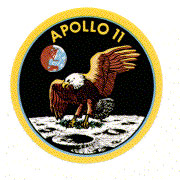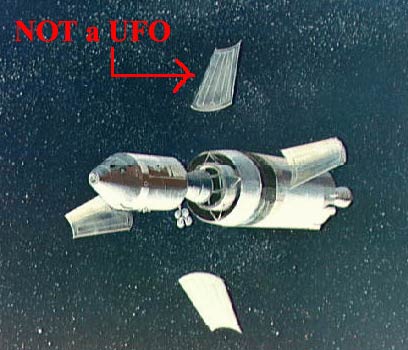
| Bad Astronomy |
|
|
|
BA Blog
|
|
Q & BA
|
|
Bulletin Board
|
| Media |
|
|
|
Bitesize Astronomy
|
|
Bad Astro Store
|
|
Mad Science
|
|
Fun Stuff
|
| Site Info |
|
|
|
Links
|
| RELATED SITES |
| - Universe Today |
| - APOD |
| - The Nine Planets |
| - Mystery Investigators |
| - Slacker Astronomy |
| - Skepticality |
Buy My Stuff

Keep Bad Astronomy close to your heart, and help make me
filthy rich. Hey, it's either this or one of those really
irritating PayPal donation buttons here.
First on the Moon: The Untold Story
(July 30, 2006)
 When you talk about how men were first sent to the Moon, there's no doubt
some of the stories get lost in time. That's why the Science Channel aired
a show called
"First on the Moon: The Untold
Story".
When you talk about how men were first sent to the Moon, there's no doubt
some of the stories get lost in time. That's why the Science Channel aired
a show called
"First on the Moon: The Untold
Story".
As the blurb for the episode says,
Most people don't know just how close Buzz Aldrin and Neil Armstrong came to death on their historic voyage. Now, with the discovery of a lost tape, insight from top scientists, and previously unreleased documents, we present the untold story.
That would be a great story, if only they had gotten it right.
There were lots of little errors in the show -- like saying the Moon is 260,000 miles away, when it's actually 238,000. That may sound like a small error, but it shows that there was some sloppy script editing, and there were several more like that.
As another quick example, they also talked about flashes of light that the astronauts saw in their eyes-- these turned out to be subatomic particles (really, atomic nuclei) from space interacting with the fluid in their eyes. This is fairly well understood now. The show implies -- it even comes right out and says -- we don't understand this phenomenon, which isn't true. But anyway, Buzz Aldrin refers to these particles as "high-Z" particles. The "Z" refers to the mass of the nucleus of the atom making up the particle. The higher the Z, the more massive the particle. The narrator refers to these particles shortly thereafter as "Z particles", which is really meaningless. This is arguably a small error, but it shows again that the writers didn't get their script checked by experts before they aired it, or, if they did, they didn't implement the advice.
But there was a far worse breach in reality in the show, and this dealt with the famous Apollo 11 "UFO".
On the way to the Moon, the astronauts saw something out their porthole they couldn't identify, and it appeared to be following them. They figured it might be the booster rocket that put them on their way to the Moon. The rocket, called an SIVB, had accelerated them out of Earth orbit two days earlier, and when they disconnected from it they maneuvered away. Two days later, their different orbits had separated them substantially. When the crew spotted their bogey, they called Houston control and asked how far away the booster was... and were told it was 6000 nautical miles distant-- way too far to be whatever it was they were seeing. Michael Collins, the Command Module pilot, looked at the object through the on-board telescope and said it was changing shape, sometimes looking elliptical, and other times looking L-shaped.
So what was it? UFO people have made a lot of hay from this story, and the show itself makes quite a bit of drama over it:
Buzz Aldrin: There was something out there that was close enough to be observed-- what could it be?Narrator: If it wasn't a part of their rocket, it could only be one thing: a UFO.
That's a pretty dumb thing to say. First, a UFO is any unidentified object, but using the acronym strongly implies an alien spaceship. Also, by definition, if it wasn't part of the rocket, it was unidentified, so it had to be a UFO. Duh.
The program then goes on to say:
To this day whatever it was the crew saw has not been positively identified or even publicly acknowledged.
However, this isn't entirely correct. It has been identified.
My friend David Morrison, who is an astronomer at NASA Ames in California, answers questions sent in to the Ask an Astrobiologist website. He got this very question! Here's his answer:
I just talked to Buzz Aldrin on the phone, and he notes that the quotations were taken out of context and did not convey the intended meaning. After the Apollo 11 crew verified that the object they were seeing was not the SIVB upper stage, which was about 6000 miles away at that time, they concluded that they were probably seeing one of the panels from the separation of the spacecraft from the upper stage. These panels were not tracked from Earth and were likely much closer to the Apollo spacecraft. They chose not to discuss this on the open communications channel since they were concerned that their comments might be misinterpreted (as they are being now). Apparently all of this discussion about the panels was cut from the broadcast interview, thus giving the impression that they had seen a UFO.
The service and command module stack that sent the astronauts to the Moon was inside the SIVB booster. The SIVB had four panels which opened up like flower petals to release the crew, as shown in this illustration:

The panels were ejected, and would follow roughly the same path as the astronauts themselves. The panels were curved, and as they rotated would present different profiles to the astronauts, explaining the different shapes Michael Collins claimed he saw through the telescope.
There's your UFO, folks.
But, far worse, is what Buzz said to Dr. Morrison about the interview. The show took his words out of context to make it seem like they were seeing a UFO. That is unforgivable! I understand that TV folks want to inflate some stories to make them more dramatic, and I also understand small errors like the ones I outlined above. But quoting out of context is basically lying, and is truly awful.
Then, to make the show that much more dramatic, they say
Against all odds, Apollo 11 was coming home.
That's just bad writing. It wasn't against all odds. The odds were significantly in favor of this mission working! Every part had been tested, every procedure. In fact, the show itself discusses several incidents where prior planning had saved the day. NASA knew things would go wrong, and had either planned for that contingency, or had practiced things so many times that the astronauts would be able to handle unexpected problems.
This is one of the things that irritates me most about some of the documentaries about Apollo, as well as Moon hoax believers in general. Apollo wasn't just some wacky scheme cobbled together by a handful of people-- it was a carefully planned, heavily-practiced, and expertly-executed program that had the brains of hundreds of thousands of people behind it.
It was one of the singular great achievements of humankind: sending men to another world, exploring it, and bringing them home again. Isn't that exciting enough?
Links
|
|